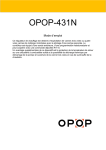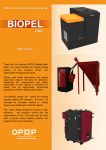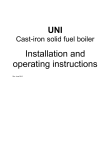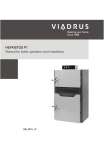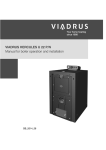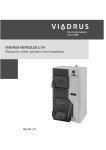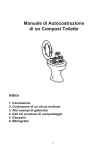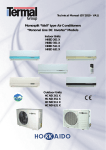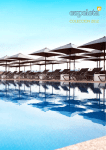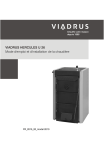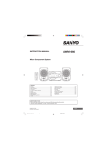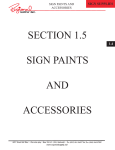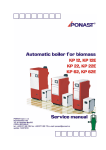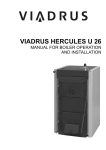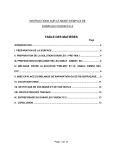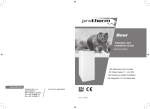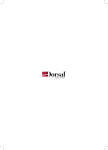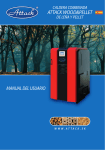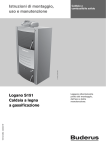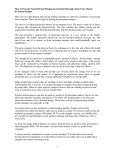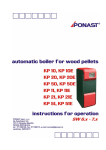Download HOT WATER WOOD BOILER ECOMAX 25, 35, 42kW USER MANUAL
Transcript
HOT WATER WOOD BOILER ECOMAX 25, 35, 42kW USER MANUAL 2012 Manufacturer: 1 Page Contents 1. Safety instructions 3 1.1 Basic safety precautions 3 1.2 Fire protection in installing and using heating appliances 3 1.3 Operators and supervisors 4 2. Use 4 3. Technical description of the boiler 4 4. Technical parameters 6 5. Fuel material 6 6. Accessories 7 7. Preparing the boiler for commissioning 7 7.1 Binding standards for designing and installing the boilers 7 7.2 Boiler connection to the hot water system 7 7.3 Boiler connection to the smoke duct and chimney 9 7.4 Boiler connection to the power grid 9 8. Operating and maintaining the boiler 10 8.1 General principles 10 8.2 Operating modes 10 8.3 Adding fuel material 11 8.4 Control principle 11 8.5 Operation adjustment 13 8.6 Boiler cleaning and maintenance 13 8.7. Overview of possible defects 14 9. Controller configuration 16 9.1 Commissioning 16 10. Electric wiring 17 10.1 Conducting the patching cables 17 10.2. Description of the connection 17 10.3 Controller parameters 19 11. Disposal 19 12. Warranty Certificate 20 2 Page 1. Safety instructions 1.1 Basic safety precautions 1. 2. 3. 4. 5. 6. 7. 8. 9. 10. 11. 12. 13. 14. 15. 16. 17. 18. 19. 20. Read carefully through the present boiler operating and maintenance manual and request adequate training from the installer The boiler connection must comply with the applicable regulations Keep the boiler room tidy Do not leave combustible articles in the vicinity of the boiler The boiler may only be operated by persons above the age of eighteen Do not allow children in the vicinity of the boiler Use personal protective equipment – gloves, goggles and a cap Use appropriate work attire avoiding easily combustible materials Remain cautions while handling the stoking and ash pan door Do not try to stoke with you long hair loose Do not attach multiple appliances into one and the same chimney flue Before leaving the boiler room, always make sure the chimney damper and the two doors are shut down Regularly check water quantity in the system as well as the functioning of the safety equipment Make sure the water in the system and the open expansion vessel has not frozen Use specified fuel only Do not leave the boiler unattended, ensure the heat power is consumed in the event the circulation pump stops to work In the event of boiler overheating, remove the hot firewood from the chute and allow the boiler to cool down Any repairs and interventions with the electric wiring may reserved to an authorised person with a certificate in electric engineering as provided for in Decree 50/75 Coll. When handling the side covers, disconnect the boiler from the grid by pulling out the plug from the socket Follow the warning signs 1.2 Fire protection during installation and use of heating appliances (Excerpts from ČSN 06 1008-Fire safety of local heating appliances a heat sources) When installing the appliances, the safe distance of at least 200 mm from any construction material must be adhered to. The distance applies to boilers and smoke ducts located in the vicinity of degree B, C1 and C2 combustibility materials (for the degrees of combustibility, see the Table) The safe distance (of 200 mm) must be doubled for any boiler and smoke flues located in the vicinity of C3 degree of combustibility material. The safe distance must also be doubled in the event no degree of combustibility of the combustible material is identified. The safe distance shall be halved (100 mm) in the event of use of a heat insulating non-combustible board of the thickness of at least 5 mm located 25 mm away from the combustible material (air insulation). A screening board or a protective screen (over the protected article) must transcend the contours of the boiler including the smoke ducts by at least 150 mm on each side and project at least 300 mm above the top surface of the boiler. A screening board or a protective surface must also be provided to any fixtures made of combustible materials unless the safe distance can be adhered to (such as in mobile vehicles, weekend houses, etc., for details see ČSN 06 1008). The safe distance must also be adhered to when placing fixtures in the vicinity of the boilers. If the boilers are located on the floors made of combustible materials, the same must be fitted with a non-combustible heat insulating pad reaching at least 300 mm beyond the contours of the boiler on the side of the stoking and ash pan openings and at least 100 mm on the other sides. All materials that display A degree of combustibility may be used as non-combustible heat insulating pads. Degree of combustibility of construction materials and products A - non-combustible B - difficult to ignite C1 – hardly ignited C2 – normal combustibility C3 – easily ignited Construction materials and products classed into degree of combustibility (excerpt from ČSN 73 0823) Granite, sandstone, concrete, bricks, ceramic tiles, mortar Fireproof plasters, etc. Acumin, isomin, heraclit, lignos, basalt felt boards, fibreglass boards, "novodur", etc. Hardwood (oak, beech) hardboards, plywood,”sirkolit”, “werzalit“, hardened paper (“umakart”) Coniferous wood (pine, larch, spruce),particle boards, cork boards, rubber flooring (“Industiál”, “Super”) Fibreboard (hardboard, sololaquers, etc.), cellulose materials, polyurethane, polystyrene, polyethylene 3 Page 1.3. Operators and supervisors Boiler operators must follow the operation and maintenance manual. Any interventions with the boilers that could endanger the health of the operators or those sharing the household are inadmissible! The boilers may only be operated by persons above the age of 18 familiar with the manual and operation of the boiler. It is inadmissible to leave children unattended near the boilers in operation. When operating solid fuel boilers, it is prohibited to use combustible liquids to fire up as well as to increase the nominal power while the boiler is in operation (overheating). No combustible articles may be cast towards the stoking and ash pan openings and the ashes must be put away in non-combustible vessels with lids. The boilers in operation must be under frequent supervision of the operators. The user may only carry out such repairs that consisting in the plain replacement of a spare part supplied (such as shaped fireclay bricks, sealing cords, etc.). While operating the boiler, caution must be exercised to ensure tightness of the doors and cleaning holes. These must at all times be closed with care! The user must not interfere with the structure and electric wiring of the boilers! The boiler operators must regularly check the water filling level of the heating system and check the pressure meter function. In the event of overheating, the operator must shut off primary air supply and collect the fire wood including the hot charcoal into a non-combustible vessel. If the water has boiled out of the heating system, it must not be filled into the boiler until after the latter has cooled down! Otherwise the boiler and the heating system will be damaged! An overheated boiler and heating system may only be recommissioned after all boiler and heating systems have been thoroughly checked (this particularly applies to all safety systems). 1.4 Type of environment The boilers may only be used in the basic “regular environments" as specified by ČSN 33 0300. The boilers must be installed in a boiler room where access of air required for the combustion process is ensured; the boilers must be based on a noncombustible pad. It is prohibited to position the boilers in residential spaces (including corridors)! Warning: In circumstances resulting in the risk of temporary ingress of combustible gases or vapours and while performing works that might imply a temporary risk of fire or explosion (e.g. when gluing the lino, PVC, etc.), the boilers must be put out of use in time and well in advance. No articles made of combustible materials may be placed on the boilers and within smaller than the safe distance away from them! 2. Use The ECOMAX series hot water boilers are intended for heating villas or adequate production departments. The boilers must be installed in specified working environments only. The boilers are supplied in basic design controlled by an operating thermostat only and with electronic control which ensures boiler power, control of the circulation pumps and, where relevant, control of the mixing valve. The boiler must be operated in line with the requirements for the parameters of the chimney and the heating system. The temperature of water returning to the boiler must not be less than 65°C. We recommend using a mixing valve and a water storage tank. 3. Technical description of the boiler The core of the boiler is the body welded together out of steel plates. In the upper part of the body, a chute is fitted, equipped with a closing stoke door. The lower part of the body is fitted with a circular combustion chamber with a closing ash-pan door. The two spaces are mutually separated by a ceramic nozzle. An air duct is provided in the frontal part of the body, which divides primary and secondary air. In the back part, there is an exchange, a flue gas duct, a flue gas removal branch and cleaning holes. At the very bottom of the boiler body, there is a hole of the filling and discharge valves. Scanning sensor (pressure sensor, temperature sensor and safety sensor) beds and the hot water branch pipe issuing into the heating system are welded on the top of the boiler body. The boiler body is insulated with mineral felt and clad with protective covers. A discharge fan is connected to the smoke duct outlet, where the purpose is to remove the flue gases towards the chimney. In the upper part of the boiler body there is a cooling loop. In the upper part of the flue gas duct, there is a chimney dumper controlled from the frontal part of the boiler. Control and display elements contributing to the proper functioning of the boiler are installed on the boiler casing. 4 Page Description and drawing of the boiler 18 10 7 11 16 1 5 6 9 3 17 2 4 8 1 – Filling door 2 – Cleaning door 3 – Chute 4 – Combustion chamber 5 – Chimney dumper 6 – Door screen 7 – Hot water branch 8 – Cold water branch 9 – Door closing 10 – Control unit 11 – Main switch 12 – Safety valve branches 13 – Cleaning cap 14 – Smoke duct outlet 15 – Stack valve draw bar 16 – Pressure meter 17 – Primary air valve 18 – Upper cleaning lid 12 14 15 13 5 Page 4. Technical parameters Boiler type ECOMAX 25 Nominal power Chute volume Water volume Outlet branch diameter Maximum boiler width Maximum boiler depth Maximum boiler height Chute depth Maximum log diameter Maximum log length Operating chimney draught Maximum working overpressure Maximum noise level Efficiency Mass Operating voltage Electric power requirement Electric power requirement with electronic control Protection kW 3 Dm 3 Dm mm mm mm mm mm mm mm Pa kPa dB % kg V/Hz W W ECOMAX 35 ECOMAX 42 25 120 60 160 612 850 1200 500 220 300 20-25 200 65 83 270 230/50 21 30 35 170 68 160 612 1000 1200 500 220 500 20-25 200 65 81 360 230/50 21 30 42 200 78 160 712 1120 1475 650 220 500 20-25 200 65 79 454 230/50 41 50 IP 20 IP 20 IP 20 Nominal power and efficiency were measured at 11% firewood humidity 5. Fuel material The fuel material specified is lump wood. No wood quality is specified. It is recommended to burn lump wood cut in maximum lengths as per the table of technical parameters. The wood must be combusted as dry as possible, with at least 15% humidity max. Damp wood releases water when combusted, which then condensates on the walls of the boiler body and the chimney. This results in the emergence of aggressive substances which markedly reduce the boiler and chimney life. Burning damp wood also results in a marked boiler power reduction. Indicative table of the calorific value of wood mass depending on the water content Calorific value Humidity (%) 15 20 25 30 35 40 45 50 55 60 ( kWh/kg) Coniferous 4.329 4.035 3.740 3.446 3.151 2.856 2.562 2.267 1.973 1.678 Deciduous 4.057 3.779 3.500 3.222 2.943 2.664 2.386 2.107 1.829 1.550 6. Accessories The following accessories are supplied along with the boiler: Steel brush Scraper Discharge fan Counterflanges 1 unit 1 unit 1 unit 2 units Screw M8 x 25 Nut M8 Washer 8.2 Operating Manual 8 units 8 units 8 units 1 item 6 Filling valve Gasket Warranty Certificate 1 unit 2 units 1 item Page 7. Preparing the boiler for commissioning Prior to putting the boiler into operation, the conditions stipulated under the relevant ČSN must be adhered to (such as chimney inspection and approval of fitness for purpose by the Chimney Authorities, a heating system designed calculated for this type of boiler, completion of a heating test, etc.). Installation of the boiler is conditioned by the connection of the controlled mixing valve in the primarily heating water circuit and connection of a safety discharge valve, TS 130. The connection of the safety discharge value is mainly necessary in the event of a use of an uncontrolled mixing valve in the primary heating water circuit. In the event that the specified safety discharge valve is not used, emergency removal of the residual heat in the event of power failure needs to be ensured while designing the heating system and installing the boiler, where the pumps and the servo-drives of the mixing valves are blocked. At the beginning of the heating season, it is always necessary to check the filling and de-aeration of the heating system! 7.1 Binding standards in designing and installing the boilers ČSN 06 0310 - Heating systems in buildings – Design and installation ČSN 06 0830 - Heating systems in buildings – Safety equipment ČSN 73 4201 - Chimneys and smoke ducts – Designing, executing and connecting fuel material consuming appliances ČSN 06 1008 - Fire safety of local heating appliances and heat sources ČSN 07 0240 - Hot water and low pressure steam boilers ČSN 07 0245 - Hot water boilers with power up to 50kW ČSN EN 13501-1 - Fire classification of construction products and building constructions – Part 1: Classification based on response to fire test results 7.2 Boiler connection to the hot water system The boiler shall be connected to the heating system using flanges to be welded onto the pipes of the heating system. A gasket must be inserted between the flanges and bolted together using M8x25 bolts. A TS 130 safety discharge valve shall be fitted. The fixture must be bolted to one of the lateral 3/4“ outlets and a measuring probe shall be inserted into the sink between the outlets. Connect the cold water branch of the water mains to the TS 130 fixture. Connect the sanitation outlet to the other 3/4“ outlet. In the event of boiler overheating, the thermostatic valve integrated in the fixture shall open the cold water supply into the cooling loop. After passing through the cooling loop, the cooling water flows spontaneously away into the sewerage system. Once the boiler has cooled down, the water flow rate is automatically stopped. Connection of the safety outlet fixture is a pre-condition to safe boiler running. The boiler may only be connected up by an expert company or a professional heating engineer. Safety valve connection chart The boilers are partially protected against overheating by a safety thermostat. The thermostat switches off the fan once the water o temperature in the boiler exceeds 95 C (the condition being moreover indicated by the failure indicator LED). This will result in the boiler passing into the steady heating mode and gradually reducing its power. Once the boiler water temperature drops o by approx. 15 C, the safety thermostat will switch the fan back on and the boiler will ramp up to the required power. The present system of boiler protection only works reliably under the condition of steady supply of pressurised cold water from the water mains (pay attention to domestic water plants in the event of power failures). Please also note that the safety systems described above are only fully and reliably functional under the condition of electric power supply. Therefore, the very issue must be addressed, for hot water systems with forced circulation, by connecting a part of the heating system to a gravity circulation circuit with the minimum power consumed being at the level of 20% of the nominal boiler power, as a minimum requirement. 7 Page Chart showing connection of the boiler to the gravity circulation heating system (indicative chart with no claim to completeness) Chart showing connection of the boiler to the system with a pressure expansion vessel (indicative chart with no claim to completeness) A safety pressure valve must be used, whose opening overepressure is 180 kPa! The valve must be fitted to the hot water outlet from the boiler, as close to the outlet pipe as possible. Chart showing connection of the boiler to a forced circulation system (indicative chart with no claim to completeness) For a basic design boiler without electronic controls, the circulation pump must be connected via an external control unit (pump protection + pump switching clamp-on thermostat), which may be ordered as special boiler accessories. For an electronic control boiler, the pump must be connected right from the boiler and is controlled by electronic controls. 8 Page 7.3 Boiler connection to the smoke duct and chimney The boiler connection to the flue duct and chimney must correspond to the relevant standards and regulations and must be approved by the relevant Chimney Authorities. Smoke duct The smoke duct must issue into the chimney vent. Unless the boiler can be connected directly to the chimney vent, the respective extension to the smoke duct must be as short as practicable. However, adequate heating surface longer than 1 m must be provided and it must rise towards the chimney. The smoke ducts must be mechanically firm, sealed against infiltration of flue gases and cleanable on the inside. The internal cross section of the smoke duct must not exceed the internal cross section of the chimney flue and it must not be tapering toward the chimney. Use of a greater quantity of smoke knuckles is not recommended. Smoke ducts must not be conducted through other residential or utility units. The method of executing the passages of the smoke duct though structures made of combustible materials are given in Annexes 2 to 3 to the ČSN 06 1008 standard, and are mainly suitable for mobile devices, wooden weekend houses, etc. Chimney The chimney must be designed for such a size as to ensure that the chimney vent develops adequate draught at all times and safely removes the flue gas into the atmosphere. We recommend that the vent be lined. Indicative chimney dimensions recommended for ECOMAX boilers: 20 x 20 cm min. height 7 m 15 x 15 cm min. height 12 m diameter 20 cm min. height 8 m In the event of an excessive chimney draught (the chimney draught automatically lifts the primary air flap allowing the boiler to burn even after the fan has been put out), the proper functioning will call for installation of a draught controller. The exact chimney size and structure determination is determined by ČSN 73 4201 and ČSN 73 4210. 7.4 Boiler connection to the power grid The boilers must be connected to the 230 V / 50 Hz power grid by a network cord and a plug. The socket connection must conform to the applicable ČSN standards. An unprofessional intervention in the electric wiring of the boiler will result in the latter becoming damaged and may lead to fatal injuries! 8. Operating and maintaining the boiler Prior to commissioning the boiler, the present boiler operation and maintenance manual must be read carefully through; where a boiler with electronic controls is being commissioned, the relevant manual covering the electronic controls must also be carefully read through. 8.1 General principles • • • • • • • • • Bearing in mind the safety of all users of the system, read carefully through the present safety precautions and follow them. Prior to using the system, become familiar with the User Manual and adhere to the recommendations indicated therein. Use the equipment exclusively for the purpose for which it is intended using the method described. The elements of the system are powered by grid voltage. When handling these elements, pay attention to your safety and protect yourselves against electric shock injuries. Do not handle the system elements with your hands wet and protect the equipment against contact with liquids. Penetration of water, other liquids or foreign particles into the elements of the equipment may cause serious malfunctions with its short circuits and leakage currents with severe implications for user safety and functioning of the control or heating system. The users must not uninstall any system elements. Some system elements are powered up by grid voltage – risks of electric shock injuries. If any part of the equipment falls down, allow the instrument to be checked by a professional before putting the same back into operation. Damage not visible to the naked eye may too jeopardise user safety. Do not use system elements that exhibit the signs of damage. When cleaning or maintaining the elements, do not use combustible liquids, their use may lead to emergence of fire. Use original accessories or accessories specified by the manufacturer only. Al parts of the equipment must be positioned and kept out of reach of children and toddlers; prevent their being damaged accidentally by children. Damage to an element may lead to a severe injury of the child. 9 Page 8.2 Operating modes o We recommend setting the boiler water (primary circuit) to the temperature of at least 70 C. The low operating boiler temperature supports condensation of tar components on the boiler walls, thus bringing out corrosion which substantially reduces the boiler life. Fan power Fan blocking Operating mode of the controller Manual mode, the fan and circulation pump switched on Pump operation Stoking Running Lack of fuel material Manual operation Change in value + - Confirmation buttons Boiler output water temperature Outdoor temperature Setting the required temperature for the basic design Selectin of an equithermal curve for equithermal design with an outdoor sensor Fan blocking – in order to make the firing up of an extinguished boiler more comfortable, the flue gas extraction fan operation may be interrupted thus avoiding having the match blown out by the undesired draught of the flue gas fan. Once the boiler door is opened, the flue gas fan is always switched to full power so that no flue gas leakage into the boiler room occurs. Manual operation – switches the fan and circulation pump regardless of the operating mode of the boiler and output water boiler temperature. Setting the required temperature – for basic design only; the controlled ensures supplies of heating water into the system according to the user-set temperature. Selection of equithermal curve – for equithermal design with an outdoor temperature sensor only. The user defined parameters of slope and heel point determine the nature of the equithermal curve, according to which the output water boiler temperature is calculated. Pressing the OK button in the basic menu displays the history of the controller’s operational values. The buttons may be used to change the resolution of the chart and the + - buttons are used to move across the time axis. The chart memory is roughly for 4 hours. 8.3 Adding fuel material Additions of the fuel material take place via a stoke door after opening the filling door. Handle the door with the chimney dumper open only. Given a proper function of the boiler, these conditions are met automatically once the following steps are taken: Open the chimney dumper with a draw bar. Wait for approx. 1 minute before slowly opening the filling door. Tilt down the screen with a fire hook and assess the remaining lumps of firewood. Put more wood on the hot ashes. Close the screen. Close the filling door and retighten the screw cap with caution. Use the draw bar to close the chimney dumper. The boiler will gradually ramp up to the required power. The boiler combustion time with the full chute depends on the humidity of the fuel material and the power consumed. Warning: After the stoking, the chimney dumper must be closed! An open chimney dumper will allow uncontrolled burning of the boiler due to continuous intake of secondary air. Boiler overheating is imminent! 10 Page Notice: In the inhibited mode, the firewood does not burn but rather smoulders and imperfect combustion occurs, releasing smoke gases at an inappropriate composition. The boiler gets clogged and tars in the chute thus reducing its life. In terms of heating ecology and boiler life, excessive heat energy or scheduling of the heating process should be addressed by means of storage tanks and their controlled discharging. Make sure the firewood is as dry as practicable, see Chapter 5. 8.4 Control principle The controller covers the automated burning process in keeping with the required parameters. In all modes (basic, equithermal, controlled) fan power is controlled based on the required boiler water output temperature. As a default, we recommend operating the boiler in automatic mode. As a result, the control of the extraction fan is automated without the need for an intervention by the user. The only setting that must be done is that of the maximum output boiler water temperature. temperautre The burning process is divided into three operating modes shown in the image below. Condensation temperature Required temperatre teplota Limit temperature (fan off) Firing up Off Stoking fuel material (door contact) Stoking fuel material (door contact) Operation On Inhibition Firing Operation On time Off 11 Page Operating statuses of the boiler in automatic mode 1) 2) 3) Firing up – With insufficient heating water temperature the circulation pump is switched off. The fan slowly increases its power until the heating water temperature exceeds the condensation temperature. Then it passes into the operation stage Operation – The boiler power is modulated in such a way as to ensure the boiler output water temperature is as close to the required temperature as possible. The circulation pump is on and hot water is supplied to the heating system. Inhibition – With the heating water temperature decreasing under the condensation temperature, the boiler switches off the circulation pump and fan. The controller will wait for the operator to stoke some more fuel material. After the boiler door is opened, firewood stoked and the boiler door closed the controller goes back to the firing up stage. Inhibition For all configurations, a remote spatial thermostat with a switching contact may be connected to the controller. (Not heated up – contact closed, heated up – contact open). Once the boiler heats the given room up and switches the spatial thermostat open, the boiler will pass to inhibition shutting down the circulation pump. Caution! The thermostat constant must be separated, potential free. The thermostat must not switch other voltages, and under no circumstances must it switch 230VAC network voltage. Otherwise, controller damage is imminent. 8.5 Operation adjustment Adjusting the operating draught of the boiler The boiler has been adjusted to the specified chimney draught at the production plant (depending on the type of the boiler, 20-25 Pa – see the Technical parameters of boilers). The size and mass of the primary air flap shutting off air supply to the boiler thus regulating the combustion corresponds to this. In the event the chimney exhibits a higher than specified draught, a greater consumption of primary air and, by inference, a more rapid fuel material loss will occur causing the boiler efficiency to drop. The boiler is also more difficult to control and the standby time in “hot reserve” is reduced. The problem may be solved by installing a draught controller between the boiler and the chimney. The draught controller may be ordered as special boiler accessories. No other ways of adjusting the boiler are admissible and where necessary, the above may only be carried out by an authorised professional. In the event that the chimney does not reach the specified draught, the boiler may not achieve the required power either, which may either impair the combustion process or even lead to the boiler releasing the smoke into the space (especially whilst stoking). The problem needs be addressed by adjusting the chimney following agreement with a professional chimney company. Adjusting the stoking and ash pan door The rough adjustment of the door is completed at the production plant. Any changes that may develop in transport must be removed by the boiler operator prior to commissioning the same. Similarly, adjusting the door with the boiler in operation (such as in the event of combustion smoke penetrating into the room with the door closed or due to the wearing or the need f or replacement of the sealing cord) belong to the fundamental maintenance interventions on the boiler carried out by the operators. The actual adjustment shall be completed after releasing the M12 nuts with a pipe wrench to be inserted in the holes in the side encasing (on the hinge side). That will release the sliding hinge of the door. Slightly open the door and press on it at the hinge locations to reduce the gap between the sealing cord and the boiler frame. An appropriately adjusted door must have the same hinge gap over the entire length of the sealing edge; once the door is closed, the sealing edge must abut across the entire surface of the frame and it must be possible to freely place the hook of the screwed cap into the grip at the door frame. After this adjustment has been done, re-tighten the M12 nuts of the sliding hinge with a pipe wrench. Notice: Never retighten the door with force; otherwise the screwed cap could be damaged and the sealing cord cut through! If possible, position the boiler in such a way as to ensure easy access to the holes in the side plates. 12 Page 8.6 Boiler cleaning and maintenance The boiler should be cleaned at a greater frequency as tar and ash deteriorate heat transfer, which reduces boiler efficiency. The ash from the chute shall be swept away through the opening in the nozzle into the combustion chamber. Tar components must be removed from the boiler walls by a scraper and also swept into the combustion chamber. Make sure the tar does not flow or impurities falling to the air flap. If so, release the flap and scrape the tar. The air flap must be easy to open and close. Notice: The primary air flap is an important boiler control element. Therefore, it must be regularly checked and the air duct space must be kept clean! The fallen lumps of wood prevent opening the flap and thus make it impossible to achieve the required boiler power. At the same time, the tar on the walls of the air duct hinders reliable closure of the air flap thereby bringing about uncontrolled combustion that may cause boiler overheating! Sweep away the ash from the combustion chamber. If possible do not remove the A-shaped adapting piece. In the event that the shaped piece must be removed with a view to allowing a more thorough cleaning of the boiler, or due to the need for the replacement of the shaped piece, while fitting the shaped piece back into the combustion chamber, it must be moved all the way to the back wall of the chamber. Notice: If the shaped piece does not perfectly abut to the back wall of the combustion chamber, the hot flue gases pass through from the combustion nozzle directly to the flue gas exchanger, outside of the post-combustion chamber. This deteriorates the combustion process (the quantity of the flue gases does not correspond to the guaranteed values) and the power and efficiency of the boiler drop! Unscrew and remove the upper cleaning lid and clean the exchanger space using a steel brush supplied as part of the boiler accessories. Use a scraper to clean the entire flue duct including the chimney flap. Check the tightness of the chimney flap. Where necessary adjust the flap position in such a way so that it may abut evenly to the vent from the boiler chute. Check or remove the gaskets of the cleaning lids and screw them back on. Check the gaskets of the filling and ash pan doors and where necessary replace them. Check the tightness of the doors at closure. If either door is not tight, adjust. Treat the hinges and caps regularly with graphite grease. Perform a visual check of all mechanic parts of the boiler including the ceramic shaped pieces and where necessary, replace them. We recommend trusting the replacement of any damaged parts of the boiler including the combustion nozzle to a professional service company. The condition of the heating system must be checked at least once a week (tightness, quantity of water, condition of circulation pumps, and or the eventuality of system freezing). Notice: In the course of the cleaning procedure, the ceramic shaped piece must be handled with care. Careless treatment and/or a fall from a height will cause damage and will require a replacement. 8.7 Overview of possible defects Description of malfunction Probably cause Removal method The boiler burns poorly, exhibiting a low power; the flame in the combustion chamber is dull and yellowish. Excessive firewood consumption. Fuel material with humidity above 15 % Use firewood at maximum humidity of 15 % Large and short lumps of wood (average above 150mm and length shorter by over 200mm compared to the chute depth). Primary air flap off. Flap not fully closed. Nozzle clogged. Nozzle damage. 13 Use wood lumps of correct dimensions Clean and release the flap. Check the flap tightness, clean the flap, check the condition of the return spring and position of the flap draw bar. Replace if necessary. Clean and remove any articles fallen through to the nozzle slot, or into the suction holes. Replace the nozzle. We recommend trusting the job to a specialised service company! Page Clogged secondary air vents to the nozzle. Clogged or overly contaminated exchanger space (the combustion process gets better once the ash pan door is opened). Fire clay adapting piece of the combustion chamber (roof) not moved all the way to the back wall of the chamber. In this case the boiler burning is sound yet the boiler displays a reduced power and increased firewood consumption. Boiler hard to control, getting overheated. Open or stuck primarily air flap. Excessive chimney draught – the chimney draught spontaneously opens the primary air flap (the flap keeps flapping). Boiler is hard to control and gets overheated. Open chimney flap – the boiler sucks air in, through the secondary air duct and burns in a way which is entirely uncontrollable using the traditional means. Water does not circulate in the boiler or heating system. Safety thermostat failure – the boiler (fan) is in operation despite the water o temperature exceeding 95 C Closed or insufficiently opened mixing valve. Oversized boiler The fan does not work The fan is switched off by the fan switch. The fan is off by the operating thermostat (within the electronic controls). 14 Clean the air duct between the fan and the nozzle. This must be done after removal of the front fan cover and the fan. We recommend trusting the job to a specialised service company! Clean the exchanger including the bottom vent leading from the combustion chamber to the tube sheet. Check the position of the ceramic adapting pieces in the combustion chamber. Clean and release the flap. The front boiler cover and the actual primary air flap need to be removed. When fitting them back on, make sure to centre the flap well within the air duct. The flap axis revolves along with the flap, and therefore, increased caution must be exercised when tightening the securing nuts on the flap axis. We recommend trusting the job to a specialised service company! Switch the fan by the manual switch and wait for the chimney to cool down entirely (about 1 hour). If the boiler temperature keeps rising, and you can still heat the flap flapping, a draught controller needs to be installed. May be ordered as optional boiler accessories. We recommend trusting the job to a specialised service company! Shut the chimney flap off, check for its condition and functioning. Check water quantity in the system, condition of the pump and its functioning Clean the pump filter. Must be carried out by a specialised service company! Check the function of the mixing valve. Where necessary, disconnect the mixing valve from the drive and perform an emergency manual opening of the valve. Adjust the heating system. We recommend using storage tanks. Turn the switch on. Set a higher temperature on the operating thermostat (within the electronic controls) In the event of a thermostat failure (electronic controls), replacement is required by a professional service company! Page The fan is switched off by the sub-limit thermostat. The boiler temperature has o decreased under 50 C. The fan is switched off by the limit switch of the chimney dumper. The fan is switched off by the safety thermostat. The boiler is overheated – the boiler o temperature exceeds 95 C. 9 Set another temperature level for switching the fan off – see the service settings. In the event of a failure of the thermostat or the switch, the replacement must be carried out by a professional service company! The stroke of the limit switch must adjusted or the faulty limit switch must be replaced – must be carried out by a professional servicing company! The heating system must be cooled down o to under approx. 75 C. The fan will then go automatically back on. Unless the fan goes back on despite the boiler temperature decreasing under 65°, the safety thermostat has failed-must be replaced by a professional servicing company! Controller configuration Basic The controller maintains the boiler output temperature in keeping with the user defined fixed temperature value. Equithermal The controller must be equipped with an outdoor temperature sensor. The controller will calculate the required boiler output water temperature based on an equithermal curve and the outdoor temperature. The equithermal curve must be set experimentally for each type of the site to be heated up. Given its appropriate setting, the site will be heated up optimally despite any fluctuations in the temperatures outside. The user selects the heel point (ideally at temperatures of 0°C), with the temperature outside going below zero (approx. -10 to -5°C), the slope must be set. Controlled steering Allows steering by a superior system using a 0-10V signal. This principally involves equithermal control where the outside temperature is simulated using the given external signal. 0V= +20°C, 10V= -20°C. 9.1 Commissioning Having reviewed all electric parts, check the heating circuit with an emphasis on the proper setting of the valves. Make sure the heating circuit contains an expansion vessel and there is water in the heating circuit at the appropriate pressure value. Check 15 Page the connection of the flat patching cable between the input/output module and the Ecomax control panel. Connect the power cable of the input/output module to the 230VAC distribution grid. Physically check the running of the primary air circulation pump and the secondary heating circuit pump if present in the heating system. Check the running of the flue gas extraction fan. Once the boiler door is opened, the fan must ramp up to 100 % of its power. Draught must be apparent near the boiler door towards the chimney. Once the control button with the image of the fan crossed out is pressed, the flue gas extraction fan must stop. No draught should be felt near the boiler door then. Stack the boiler with dry wood and fire it up – see chapter 8.3 Adding firewood. Once the fire has lit up reasonably, close the boiler door and unblock the fan function by repeatedly pressing the button showing the symbol of the crossed-out fan. The fan will slowly start to ramp its power up, fanning up the flames in the boiler’s fire chamber. The boiler’s primary heating circuit pump and the flue gas extraction motor must be electrically interconnected at the customer’s site. The interconnection may only be carried out by a person with the relevant electric engineering qualification. Space thermostat may be individually connected to the controller, where the former must be fitted with a potential-free switching contact; for an equithermal design an outdoor temperature sensor must be connected, to be positioned on the northern side of the building not exposed to direct sunlight, at the height of approx. 2 m above the ground. The length of the patching cable for the outdoor temperature sensor may be 15 m maximum, or 25 m maximum, for connection using a coaxial cable. Equipotential bonding must be provided on all electrically conductive parts. 10 Electric wiring The controller is powered by the 230V/50Hz network using a network cable with a bent plug and a CEE7/7 connector. The IEC 320 C13 network socket case accommodates a protective 2A/T tube fuse. The power part of the controller is screwed on inside the sheet cover of the boiler, equipped with bushings and a flat patching cable for the Ecomax control panel. 10.1 Conducting the patching cables Fix the input/output module to the boiler shell in such a way using two installation screws in such a way as to ensure the passage holes through the sheet casing of the boiler and module are in alignment. Non-combustible silicon cables under the boiler shell will be conducted via this opening. This concerns the main switch, the grounding wire for the equipotential bonding, boiler door contact, emergency thermostat and the boiler output water temperature sensor. P L N P N E E MS P N E MC K K T1 T1 P N M V P P E G TS G T G R G U T A Main switch Door contact Emergency thermostat 16 Boiler output waster temperature sensor Page 10.2 Description of the connection The controller is powered up by 230V/50Hz network using a network cable with a bent plug and CEE7/7 connector. The IEC 320 C13 network socket case accommodates a protective 2A/T tube fuse. The power part of the controller is screwed onto the inside of the boiler’s sheet case, equipped with passages and a flat patching cable for the Ecomax control panel. The opening in the bottom right-hand side corner of the base serves the conducting of the cabling under the boiler’s sheet shell. 1A/T PE L N PE N MS PE N MC KP KP T1 T1 PE N MV G TS G TA G R G UT L Space thermostat contact R 0-10V control signal (for controlled design) Outodoor temerature sensor G TS G TA G Boiler output water temperature sensor Flue gas extraction fan motor Safety thermostat Boiler door contact Primary circuit circulation pump N PE N MS PE N MC KP KP T1 T1 PE N MV Secondary circuit circulation pump Power supply PE L G UT L fuse 17 Page 10.3 Controller parameters Ecomax input/output module Size: Supply voltage: Maximum current consumption: Maximum input power: Temperature sensor input : Safety thermostat input: Open door sensor input: Fan motor output: Circulation pump output: Sec. circulation pump output: Protection Protection to EN60529: Operating temperature: Designed to: EMC tested to: 215×132×83 (width×height×depth) 230VAC 2A 260VA 2 inputs for DS18B20 digital temperature sensors 230VAC normally closed contact 230VAC normally closed contact 230VAC triac, max. 40VA 230VAC relay, max. 100VA 230VAC, permanently closed max. 100VA 2A blow fuse. IP2X up to 60°C EN60730-1 2:2001 EN 61000-4-2, EN 61000-4-3, EN 61000-4-4, EN 61000-4-5,EN 61000-4-11, EN 55022 Environment to ČSN 332000-3: AA5, AB5, AD1, AE1, AF1, AK1, AM1, BA1, BE1 Intended for base of degree of combustibility: B, C1, C2 a C3. For all conductive parts of the boiler, equipotential bonding must be performed with potential PE. Ecomax control panel Size: Supply voltage: Maximum input power: Protection to EN60529: Operating temperature: Designed to: EMC tested to: 136×72×25 (width×height×depth) 24VDC 5VA IP2X up to 60°C EN60730-1 2:2001 EN 61000-4-2, EN 61000-4-3, EN 61000-4-4, EN 61000-4-5,EN 61000-4-11, EN 55022 Environment to ČSN 332000-3: AA5, AB5, AD1, AE1, AF1, AK1, AM1, BA1, BE1 Intended for base of degree of combustibility: B, C1, C2 a C3. 11 Disposal No hazardous materials requesting special waste treatment were used in the making and packing of the boiler. The packaging consists of a wooden transport pallet, a paper carton and a flexible packing foil. After the disassembly the paper and the pallet must be burned in the boiler and the packing foil handed over to the local municipal waste landfill. At the end of the boiler life, the same must be dismantled and the sorted material submitted to the collection yards as per the individual types of materials and in keeping with the applicable regulations. Used boiler material: - steel sheet grey iron aluminium allow in the fan body glass fibre insulation refractory concrete synthetic or powder paint coat electronic components copper conductors silicon conductor insulation 18 Page 12. WARRANTY CERTIFICATE covering ECOMAX 25, ECOMAX 35, ECOMAX 42 hot water boiler, fabrication no. Manufacturer: OPOP spol. s r.o., Valašské Meziříčí Tel.: 571 675 589, Fax.: 571 611 225 Shipped from the plant:_________________________________________ Warranty terms: The present warranty sheet contains quality and completeness certificates. The manufacturer confirms that the product has been checked and proved to conform, with its design, to the technical conditions and ČSN EN 303-5. We provide the warranty for the quality, function and workmanship of the boiler during 24 months of the sale to the respective customer, yet for the maximum of 30 months from removal from the production plant, namely by pledging to remove any defects demonstrably due to faulty material, design or workmanship within as little time as possible at our own expense, provide that the boiler: • • • • • • is in regular technical condition as stipulated in the operating manual is connected to a chimney vent to ČSN 73 4201:1989 has not been mechanically damaged with force (there has been no unauthorised interventions save for any action provided for in the Operating Manual) the chimney draught to ČSN must correspond to the value indicated in Table 2, depending on the boiler type the customer submits the present warranty certificate, duly filled in, when lodging a complaint the manufacturer’s instructions governing the use of pressure expansion vessels have been adhered to Note: When notifying a defect, the present Warranty Certificate must be submitted at all times, and the exact address and the circumstances, in which the defect occurred must be indicated. Our company will decide on the method and place of repair. Technical check completed on________________________ Sold on ______________________ Note: For the steel weldment – we guarantee its lasting tightness during 60 months from removal from the production plant. The present warranty is preconditioned by the fact that no pressure expansion vessel has been used in the heating system and the leakage has occurred due to low-quality material or welding work. The warranty cannot be enforced for faults down to the operators. If the warranty claim is acknowledged during an extended warranty term, we will provide the user with a replacement steel weldment using unit transport or personal delivery. The costs associated with the transport, replacement and return of the faulty weldment to the production plant shall be borne by the user. Unless the faulty weldment is returned to the production plant within 30 days of its dispatch or handover of a replacement weldment, the weldment will be charged to the user at its full value. A warranty term of 24 months from collection applies to the weldment replaced under the extended warranty term, i.e. 60 months. The boiler weldment is treated with black water paint which may lead to the peeling of the coat. The peeling coat shall have no effect on the function of the boiler. After the first firing up, the coat will get burn out. 19 Page Procedure for lodging a complaint: 1) Submit the warranty certificate with a document attesting to the payment of the product either in person, by post or fax. 2) Report the exact address or telephone and indicate the circumstances in which the defect occurred. 3) The service engineer will let the user know of the method of dealing with the complaint: a) sending the complaint part for replacement b) in the event the procedure under point a) is impossible, the manufacturer shall be entitled to select the method, deadline and execution of the repair by their service engineer or contractual partner c) the user must allow the producer to complete the repair under point b) d) unless the user allows access to the installation with a view to conducting the repair, the manufacturer shall consider the complaint to have been completed e) in the event the defect proves impossible to be removed, the user shall be entitled to a replacement of the defective part f) in the event the complaint proves unjustified, i.e. the defect or leakage of the weldment is not confirmed by the service engineer the lodger of the complaint will be charged with the costs associated with the inspection and journey to the user’s site g) where it becomes necessary to speed the complaint up, please contact the manufacturer’s servicing engineer at the following phone number: 571 675 252 or 602 743 970 Dear Customer, We are very happy for you to have opted for our product. The decision entitles to a 10% discount on spare parts. In order for you to obtain the advantages above, you must fill in the registration card and send it to our address: OPOP spol s r.o. Obchodní oddělení Zašovská 750 757 01 Valašské Meziříčí After we receive your filled out form, we will provide you with your Customer Card by return of post, which makes you eligible for the discounts on the price of the spare parts from the manufacturer. When ordering spare parts you must always mention your Customer Card number. Thank you for your trust. Cut here and send to our address …………………………………………………………………………………… 14. REGISTRATION CARD Name………………………….. Product fabrication no.……………………. Surname………………………… Salesman………………………………….. Street and no. ……………………..Type of product………………………………. Town…………………………… Postcode…………………………….. Phone number (optional)………………………… E-mail …………………………… Signed……………………………………………… 20 Page OPOP, spol. s r. o. Zašovská 750 757 01 Valašské Meziříčí Bank details: Komerční banka a.s., account no.:1608851/0100 Reg. no.: 47674105, VAT no.: CZ 47674105 Phone: Sales Dept: 571 675 589, Secretariat: 571 611 250, Production: 571 675 405 Sourcing: 571 675 114, Finance: 571 675 472 Fax. 571 611 225 21 Page





















